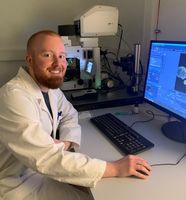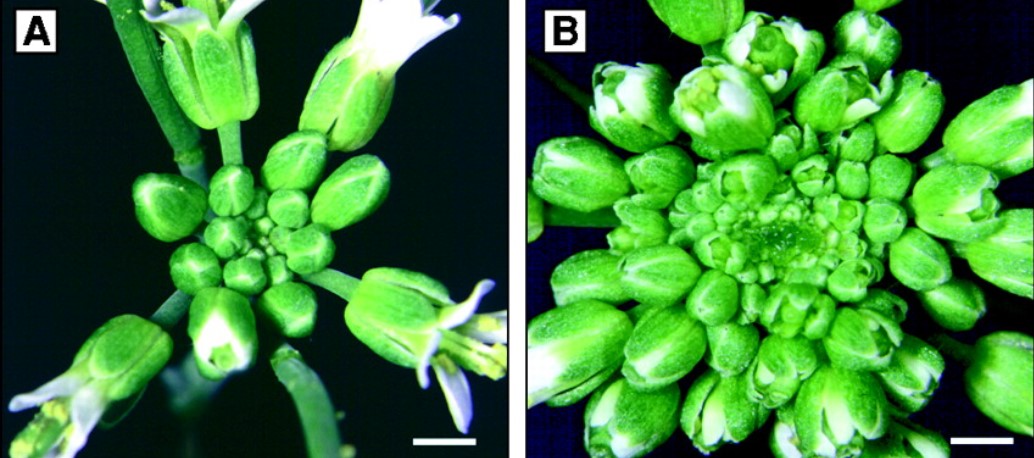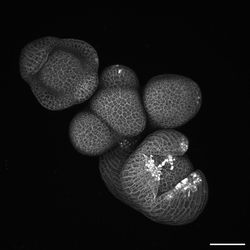Let's talk about meristems – the driving forces of plant growth
In contrast to animals, plants have evolved a type of development in which all organs of the adult organism, like flowers or leaves, are generated post-embryonically; i.e. after they have germinated. This allows plants, which are unable to change their location, to adapt their growth and architecture to the environmental cues they are exposed to (e.g. drought, heat, flooding, nutrient deficiency). Besides, this also explains the natural variation in organ number and shape between plants of the same species.
But what facilitates this highly flexible development? The answer to this question is hidden within so called meristems, which contain plant stem cells. The two primary meristems, the root apical meristem (RAM) and the shoot apical meristem (SAM) are initiated at the tips of the two opposite poles of the young embryo. During growth, the RAM is responsible for the production of the root system and the aboveground tissue of the plant originates from the SAM.
Importantly, while the meristems generate tissue throughout the whole lifespan of a plant, they also have to maintain their own stem cell population. If a meristem fails to keep that balance, it may either lose its ability to produce new organs or generate too many of them.
By studying meristems, we can learn how to optimize plant growth for our needs. Typically, the investigation of complex biological processes such as stem cell maintenance, is conducted on “model organisms”. Advantageous characteristics like a short generation time, a small size and easy cultivation make Arabidopsis thaliana a widely used model in plant biology. Insights obtained from Arabidopsis can be applied to agriculturally relevant crops to improve beneficial traits as well as seed production. Check out Edgar’s planter’s punch, if you want to learn more about grasses like barley or maize and how research on their development can help to increase grain yield.
In our institute, we attempt to uncover the mechanisms that are responsible for the balance of differentiation and stem cell maintenance in the SAM. These mechanisms involve the coordinated interplay of several signaling pathways, each consisting of many different protein classes such as peptides, receptors and transcription factors. Modern imaging techniques enable us to precisely visualize their (sub-)cellular localization and can uncover additional characteristics like their mobility or interaction with other proteins. Furthermore, advanced molecular methods allow to modulate the abundance of a specific protein of interest within a defined tissue. In combination with the aforementioned imaging techniques, it is possible to observe how the absence or presence of a single protein affects a certain developmental stage.
The shoot apical meristem of Arabidopsis thaliana (structure in the middle) surrounded by young flower buds. The movie shows a series of successive images that were taken with a microscope and on the right, we see a projection combining the information from all of those single images. The shoot apex was treated with a cell wall staining dye before imaging. The size of the scale bar is 0.05 mm.
One important class of proteins acting in the involved signaling pathways are receptor-like kinases (RLKs). These receptors are located at the plasma membrane and sense signals originating from nearby cells. In my PhD project, I want to understand which downstream processes are activated by a specific RLK after perception of a signaling peptide, and how this ultimately affects SAM morphology.
Planter's Punch
Under the heading Planter’s Punch we present each month one special aspect of the CEPLAS research programme. All contributions are prepared by our young researchers.
About the author

Meik Thiele is a PhD student in Rüdiger Simon’s group at the institute of Developmental Genetics (HHU Düsseldorf). Meik’s research focuses on the shoot apical meristem maintenance of the model species Arabidopsis thaliana and how a specific receptor takes part in its regulation. Before joining the CEPLAS Graduate School, he studied “Quantitative Biology” as a cooperative study course offered by the Heinrich-Heine-University Düsseldorf and the University of Cologne.
Further reading
Schlegel, Jenia, et al. Control of Arabidopsis shoot stem cell homeostasis by two antagonistic CLE peptide signalling pathways. Elife 10 (2021): e70934.

